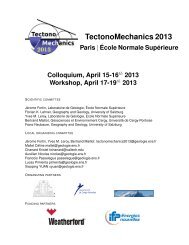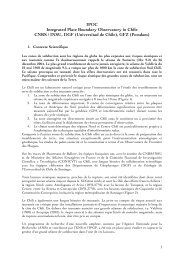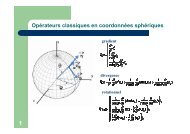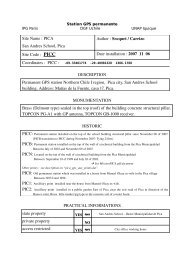PDF file - Laboratoire de Géologie de l'Ecole normale supérieure - Ens
PDF file - Laboratoire de Géologie de l'Ecole normale supérieure - Ens
PDF file - Laboratoire de Géologie de l'Ecole normale supérieure - Ens
You also want an ePaper? Increase the reach of your titles
YUMPU automatically turns print PDFs into web optimized ePapers that Google loves.
SIMONS ET AL.: GPS MEASUREMENTS IN S.E. ASIA TO REFINE SUNDALAND MOTION X - 7<br />
3<br />
2<br />
2<br />
2<br />
2<br />
1<br />
1<br />
1<br />
1<br />
2<br />
1<br />
1<br />
2<br />
1<br />
3<br />
1<br />
1<br />
2<br />
2<br />
1<br />
3<br />
Figure 6. GPS Velocities w.r.t. Sundaland. Shown are the residual velocities w.r.t to the updated Sundaland pole for<br />
the 28 sites used (open dots with black vectors).<br />
differences between the estimated and the ITRF-2000 velocities for<br />
IGS sites used in the mapping are typically below 1 mm/yr for the<br />
horizontal and a few mm/yr for the vertical components. The IGS<br />
sites that were mapped along with the S.E. Asia network, are also<br />
within these differences. For stations BAKO, NTUS, PIMO and<br />
DARW the velocities computed in this analysis are more accurate<br />
than in ITRF-2000, since they are based on longer time series.<br />
Based upon the results in Table 6, taking into account the velocity<br />
differences for IGS sites closest to the S.E. Asia network as well as<br />
the internal accuracy of this network, it can be conclu<strong>de</strong>d that the<br />
S.E. Asia computed velocities have absolute accuracies, which are<br />
in agreement with the formal errors (1-) obtained in the final step<br />
in this section. The horizontal velocity vectors have (1-) errors<br />
range from about 0.3 mm/yr for the permanent stations to 0.5 to<br />
2.5 mm/yr (<strong>de</strong>pending on the number of observations/time elapsed)<br />
1<br />
1<br />
1<br />
2<br />
1<br />
3<br />
for the episodically observed sites. A number of new sites have<br />
larger errors because they were only observed twice in the past year<br />
(mainly Sulawesi sites and 1 THAICA site in South-Thailand). The<br />
velocity vectors along with their (3-, for more clearness) uncertainties<br />
are shown in Fig. 4. The velocity field is available from the<br />
first author upon request and it can be used as a reference solution,<br />
or to connect to other regional network solutions.<br />
4. Sundaland Motion and <strong>de</strong>formation<br />
4.1. Pole estimation<br />
In this paper, we present an updated Sundaland pole in ITRF-<br />
2000 <strong>de</strong>rived from the velocity field obtained by processing GPS<br />
data <strong>de</strong>scribed in the previous section. This pole was carefully es-<br />
0






